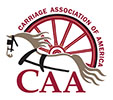
Do sleighs have brakes? The short answer is yes, some do, as you can see in the image here. The iron is curled, allowing some flexibility while holding the spike in the ‘up’ position. When the driver needs to engage the brakes they would simply use their foot to apply the brakes.

Popular American sleighs like the Albany and Portland are rarely seen with brakes. In fact, we rarely see pictures or drawings of any type of American sleigh with brakes. Despite this, we know that there were several patents filed with the U.S. Patent Office to improve sleigh brakes. It is difficult to know exactly why they weren’t more popular – better roads, different type of harness (with breeching) and just different cultural ideas could all be factors.
What about skid brakes and chock blocks like those used with coaches and wagons? Skid brakes are impractical as they simply slide on the same surface as a sleigh runner. Chock blocks or spiked blocks are sometimes used with bigger sleighs and sleds. Verbal tradition tells us that this system was especially used in the American West, sadly an image has not been located to document this, possibly because snow is covering the blocks in the images researched.
Sleds, sledges and sleighs, as we think of them today, are primarily used in winter but they can be, and often were, used throughout the year, particularly sleds. There is documentation of sleds being used to transport the ill, injured or dead as they created a smoother ride over uneven ground than wheeled vehicles. While the word ‘sleigh’ is used with many of the patents it is possible that this is simply referring to any horse drawn vehicle without wheels.
Let’s explore a few examples of American sleigh brakes through patents.
J.R. McAlister Sleigh Brake – 1866

J. R. McAlister’s idea for a sleigh brake involved the front of the sleigh, rather than the rear. “The present invention consists in so hanging brake blocks or shoes to the runner-frames of a sleigh or sled, and in so connecting them to the pole of the same, that ‘while’ they will not bear or act upon the surface of the ground when the sleigh or sled is being backed, they will come to a bearing against the ground if the sleigh is descending an inclination or a hill, whether it be more or less steep, as will be obvious from the following detail description of the same, reference being had to the accompanying plate of drawings, in which- Figure l is a plan view of the under side of a sleigh or sled having my improved arrangement of brakes applied thereto; and Fig. 2, a side elevation of my arrangement of the brake shoes and hanging of the pole, with the sleigh or sled frame in vertical section.
H.W. Smith Sled Brake – 1870

H.W. Smith’s Sled Brake was patented in 1870. “The hook it is attached to the outer end of an arm, 1), extending from the rock-shaft D, to the outer end of which is attached the hand-lever E. By means of, this hand-lever the driver can raise and lower the brakes at will. The purpose of connecting an automatically self-acting lock, of any suitable description, of which no claim is made thereto under this patent. A self-acting antomatically-operating lock may be January 26,1869. My invention may the driver, as desired.
On the fender or other suitable part of the sleigh A, is bolted a long spring, G, made of wood or metal. On the front or loose end of this spring is attached lever E when the brakes are applied. If the brakes should strike any obstruction, the spring G will yield and allow the brake to pass over.”
George C. Fuller Sleigh Brakes – 1871

George C. Fuller’s sleigh brake may have been designed for a work vehicle like a bob sled (without a full fifth wheel). “The only sleigh-brake heretofore known in use has been the chain and the ordinary plow or whiffletree clevis. Both require time to attach and taking either off the Description of the Accompanying Drawing. ….When it is desired to detach the brake, a slight pull-outward on the cord draws the lever D outwardly, and the pin D becomes detached, and the latch F flies open, and the runner will pass over the bow, and the brake may then be drawn into the sleigh by the cord E without stopping the sleigh.”
Thomas Bromley Sleigh Brakes – 1873

Thomas Bromley’s design improved on the single claw or hook method. “A single claw or hook does not offer the desired safety in ascending or descending steep grades, as the same may incidentally slip by not obtaining a proper hold of the ground; and to overcome these objections I have resource to a supplementary claw or prong, I, which is pivoted between ears K, formed on the upper surface of the brake bar. Said prong or claw I is curved and pointed, and is made larger than the claw Gr, so that, when the rock-shaft is turned to operate the brake, it will be projected into the ground or ice in rear of the claw G, thus obtaining a double purchase or hold on the ground, which effectually serves to arrest the movement of the sled, obviating, therefore, all danger to life or injury to the sled.”
Written by Kathleen Haak for the Carriage Association of America.
